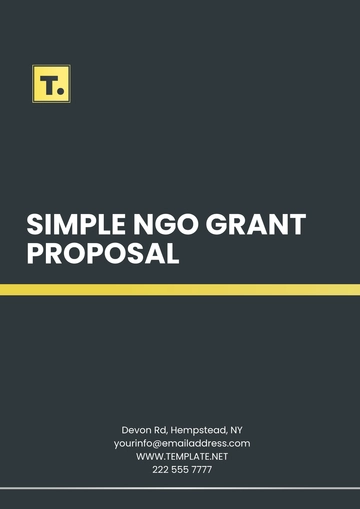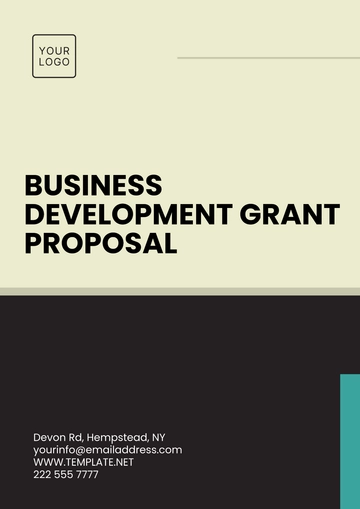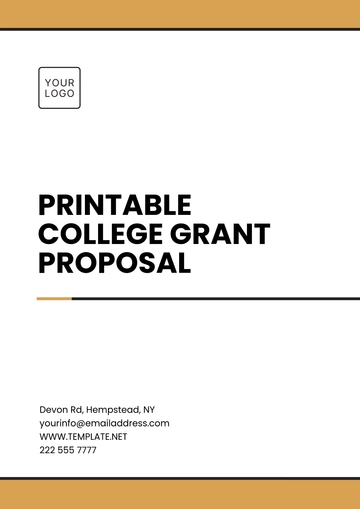Free Scholarship Grant Proposal

I. Executive Summary
A. Overview
In [2050], [Your Company Name] proposes the establishment of a comprehensive Scholarship Grant Program aimed at transforming the educational landscape for underprivileged students globally. This initiative is designed to break down financial and systemic barriers that hinder access to higher education. By providing targeted financial aid and holistic support, the program will empower a new generation of scholars, fostering both academic excellence and personal growth.
The program envisions awarding scholarships to [50] students annually, covering their full educational costs, including tuition, living expenses, and academic materials. The initiative will also establish partnerships with [10] prestigious academic institutions worldwide and introduce robust mentorship and career development opportunities. Through these efforts, [Your Company Name] aims to enhance educational equity, drive socio-economic progress, and cultivate future leaders who are equipped to address global challenges.
B. Objectives and Impact
Annual Support: Provide financial support to [50] students each year, covering all aspects of their educational journey from [2050] to [2060].
Institutional Collaboration: Forge partnerships with [10] leading universities and colleges by [2055], facilitating a broad range of academic and professional opportunities for recipients.
Mentorship and Development: Implement a mentorship program that pairs students with experienced professionals, fostering academic and career growth.
Impact Assessment: Conduct socio-economic impact evaluations every [5] years to measure the program’s effectiveness and adapt strategies for continuous improvement.
II. Background
A. About [Your Company Name]
[Your Company Name], established in [2050], has evolved into a global leader in [industry focus], known for its commitment to corporate social responsibility and community development. With a legacy of supporting educational initiatives, our company has impacted over [10,000] students through various programs aimed at enhancing educational access and quality. The launch of the Scholarship Grant Program represents a significant expansion of our efforts to address educational inequities on a global scale.
B. Purpose of the Scholarship Grant Program
The Scholarship Grant Program is designed to address critical gaps in access to higher education, particularly for students from low-income backgrounds and underserved regions. The program aims to:
Eliminate Financial Barriers: Cover all educational costs for selected students, ensuring that financial constraints do not impede their academic and professional aspirations.
Provide Holistic Support: Offer additional resources such as mentorship, career counseling, and leadership training to ensure students’ success both during and after their education.
Promote Equity and Inclusion: Focus on students from underrepresented and disadvantaged communities, thereby promoting a more inclusive educational environment.
III. Problem Statement
A. Educational Inequality in [2050]
Despite advancements in technology and educational reforms, educational inequality persists in [2050]. Key issues include:
Limited Access to Quality Education: Students from low-income families and rural areas often lack access to high-quality educational resources and facilities. According to Global Education Research Institute, approximately [40%] of students in these regions do not complete secondary education, and only [10%] continue to higher education.
Digital Divide: The disparity in access to digital learning tools and high-speed internet exacerbates educational inequalities. Students in underserved areas frequently encounter challenges in accessing online courses and resources.
B. Financial Barriers
The escalating cost of higher education is a significant barrier for many students. In [2050], the average annual tuition fee for top-tier institutions has risen to [$50,000], with additional costs for living expenses, books, and supplies bringing the total financial burden to approximately [$70,000] per year. Many families are unable to bear these costs, leading to a gap in educational attainment between different socio-economic groups. Financial aid programs often fall short in addressing the full range of students' needs, leaving many deserving candidates without support.
C. Lack of Institutional Support for Personal Development
While financial aid is crucial, it often fails to address other aspects of student development. Current scholarship programs may provide monetary support but lack comprehensive personal development components, such as:
Mentorship: Guidance from experienced professionals can significantly enhance students' academic and career outcomes. However, many programs do not offer structured mentorship.
Leadership Training: Opportunities for leadership development are often limited, hindering students’ growth in essential areas such as project management, public speaking, and strategic thinking.
Mental Health Support: Transitioning to higher education can be challenging, and many students face stress, anxiety, and other mental health issues that require targeted support.
IV. Objectives and Goals
A. Short-Term Objectives (2050-2055)
Scholarship Distribution:
Selection and Award: Identify and award scholarships to [50] students each year based on rigorous selection criteria. Each recipient will receive comprehensive support, including tuition, living expenses, and academic materials.
Academic Monitoring: Implement a system to track recipients’ academic performance and provide additional support as needed.
Partnerships with Educational Institutions:
Identification of Partners: Collaborate with [10] esteemed universities and colleges globally to ensure a diverse range of educational opportunities for scholarship recipients.
Formal Agreements: Establish formal partnerships that include student exchange programs, internship opportunities, and joint research initiatives.
Development of Mentorship Programs:
Mentor Recruitment: Engage professionals from various fields to serve as mentors. Mentors will provide guidance on academic performance, career planning, and personal development.
Program Structure: Design a structured mentorship program with regular meetings, goal-setting sessions, and career workshops.
B. Long-Term Goals (2055-2060)
Increase Scholarship Reach:
Expansion Plan: Expand the program to support [100] students annually by [2060], increasing the scope and impact of the initiative.
Geographic Diversification: Extend the program to more regions, including those with the highest need for educational support.
Socio-Economic Impact Measurement:
Impact Studies: Conduct comprehensive socio-economic studies every [5] years to evaluate the program’s effectiveness and identify areas for improvement.
Feedback Mechanisms: Develop feedback mechanisms to gather input from scholarship recipients, alumni, and community stakeholders.
Creation of an Alumni Network:
Alumni Engagement: Establish a global network of program alumni to foster ongoing connections and provide opportunities for collaboration.
Continued Support: Offer career development resources, networking events, and opportunities for alumni to contribute to the program through mentorship and philanthropy.
V. Scholarship Program Structure
A. Selection Criteria
The selection process is designed to ensure that scholarships are awarded to students who exhibit not only academic excellence but also a strong commitment to personal and community development. Criteria include:
Academic Excellence:
GPA Requirement: Applicants must have a minimum GPA of [3.8] on a [4.0] scale or equivalent.
Standardized Test Scores: High scores on standardized tests, such as the SAT or ACT, will be considered where applicable.
Financial Need:
Documentation: Applicants must provide detailed financial documentation, including family income statements and proof of economic hardship.
Assessment: A financial need assessment will be conducted to determine the extent of the support required.
Leadership and Community Involvement:
Extracurricular Activities: Evidence of participation in extracurricular activities, leadership roles, and community service will be evaluated.
Personal Statement: A compelling personal statement outlining the applicant’s goals, achievements, and vision for the future is required.
Geographic Representation:
Diversity: The program aims to support students from diverse geographic regions, including those with historically low access to higher education.
Regional Prioritization: Special consideration will be given to applicants from underserved and remote areas.
B. Scholarship Benefits
The Scholarship Grant Program offers a comprehensive package to ensure that recipients can focus entirely on their academic and personal growth:
Full Tuition Coverage:
Amount: Up to [$50,000] annually for tuition fees at participating institutions.
Additional Support: Includes coverage for lab fees, course materials, and other academic-related expenses.
Living Expenses:
Stipend: A yearly stipend of [$20,000] to cover housing, meals, and transportation.
Accommodation: Assistance with securing on-campus or off-campus housing, as required.
Academic Materials:
Budget: Up to [$3,000] annually for books, software, and other essential academic tools.
Technology Support: Provision of necessary technology, such as laptops and software, to facilitate online learning.
Health Insurance:
Coverage: Comprehensive health insurance coverage to address medical needs and emergencies.
Wellness Support: Access to mental health resources and counseling services.
Mentorship Program:
Personalized Guidance: Regular meetings with assigned mentors to provide academic and career guidance.
Workshops: Access to workshops on leadership, career development, and professional skills.
VI. Implementation Plan
A. Timeline
The implementation of the Scholarship Grant Program will follow a phased approach to ensure thorough planning and execution:
Phase | Activity | Year |
|---|---|---|
Phase 1 | Program Launch: Officially announce the program and initiate marketing efforts to attract applicants and partners. | [2050] |
Phase 2 | Scholarship Selection: Open application portal, screen candidates, and award scholarships to the first cohort of [50] students. | [2051] |
Phase 3 | Partnership Development: Formalize partnerships with [10] academic institutions, including the signing of agreements and planning of joint initiatives. | [2052-2055] |
Phase 4 | Mentorship Program Rollout: Launch the mentorship program, recruit mentors, and match them with scholarship recipients. | [2052] |
Phase 5 | First Impact Evaluation: Conduct a comprehensive evaluation of the program’s initial impact on students and communities. | [2055] |
Phase 6 | Program Expansion: Scale the program to support [100] students annually, and continue to enhance program features and partnerships. | [2055-2060] |
B. Selection Process
The selection process ensures transparency, fairness, and effectiveness in awarding scholarships:
Application Portal:
Launch: The online application portal will open in January of each year. Applicants will submit necessary documents, including academic records, financial information, and personal statements.
Accessibility: Ensure the portal is accessible globally and provides support for applicants with disabilities.
Screening Committee:
Composition: The screening committee will consist of [Your Company Name] employees, academic experts, and representatives from partner institutions.
Evaluation Criteria: Applications will be reviewed based on academic performance, financial need, leadership potential, and community involvement.
Interviews:
Stage 1: Academic interviews to assess candidates’ educational background, achievements, and future goals.
Stage 2: Leadership and personal development interviews to evaluate candidates’ potential for success and their commitment to community service.
Final Selection:
Announcement: Finalists will be notified in August, allowing them time to prepare for the academic year. Successful candidates will receive detailed information about the scholarship and its benefits.
VII. Budget and Financial Plan
The financial sustainability of the Scholarship Grant Program is crucial for its long-term success. The projected budget for the program is approximately [$5 million] annually, broken down as follows:
Expense Category | Annual Cost per Student | Total for [50] Students | Notes |
|---|---|---|---|
Tuition Fees | [$50,000] | [$2,500,000] | Covers full tuition at partner institutions. |
Living Stipend | [$20,000] | [$1,000,000] | Includes housing, meals, and transportation. |
Academic Materials | [$3,000] | [$150,000] | Books, software, and other essential tools. |
Health Insurance | [$2,000] | [$100,000] | Comprehensive coverage for medical needs. |
Administrative Costs | N/A | [$500,000] | Program management and operational expenses. |
Mentorship Program | N/A | [$250,000] | Costs associated with mentor recruitment and training. |
Total | [$4,500,000] |
A. Funding Sources
To finance the Scholarship Grant Program, [Your Company Name] will seek funding from various sources:
Corporate Sponsorships: Partner with other corporations and businesses to secure additional funding and resources.
Government Grants: Apply for grants from governmental and international bodies dedicated to educational development.
Philanthropic Contributions: Engage with philanthropic organizations and foundations to secure donations and support.
Internal Budget Allocation: Allocate a portion of [Your Company Name]'s annual budget to fund the scholarship program.
VIII. Monitoring and Evaluation
A. Academic Performance Tracking
Monitoring recipients’ academic progress is essential to ensure they are benefiting from the scholarship:
Regular Reports:
Submission: Recipients will submit academic progress reports every semester, detailing their grades, coursework, and academic challenges.
Review: Reports will be reviewed by the program administration to provide timely interventions if needed.
Mentor Feedback:
Quarterly Evaluations: Mentors will provide feedback on students’ performance, personal growth, and engagement with the program.
Adjustments: Based on feedback, additional resources or support may be provided to address any challenges faced by the students.
B. Socio-Economic Impact Assessment
Assessing the long-term impact of the scholarship program will help refine and improve its effectiveness:
Income Growth:
Tracking: Monitor the career and income trajectories of alumni to assess the financial impact of the scholarship.
Surveys: Conduct surveys to gather data on income levels and employment status of former recipients.
Community Involvement:
Engagement: Evaluate the extent of alumni involvement in community service and development activities.
Impact Stories: Collect and document success stories of alumni contributing to their communities.
Career Advancement:
Career Progression: Track career advancements and professional achievements of alumni, focusing on leadership roles and entrepreneurial ventures.
Feedback: Obtain feedback from employers and industry professionals regarding the performance and contributions of alumni.
- 100% Customizable, free editor
- Access 1 Million+ Templates, photo’s & graphics
- Download or share as a template
- Click and replace photos, graphics, text, backgrounds
- Resize, crop, AI write & more
- Access advanced editor
Secure funding with the Scholarship Grant Proposal Template from Template.net. This editable and customizable proposal template helps you draft compelling grant applications. Personalize it in our Ai Editor Tool to match your scholarship program's goals and requirements.
You may also like
- Business Proposal
- Research Proposal
- Proposal Request
- Project Proposal
- Grant Proposal
- Photography Proposal
- Job Proposal
- Budget Proposal
- Marketing Proposal
- Branding Proposal
- Advertising Proposal
- Sales Proposal
- Startup Proposal
- Event Proposal
- Creative Proposal
- Restaurant Proposal
- Blank Proposal
- One Page Proposal
- Proposal Report
- IT Proposal
- Non Profit Proposal
- Training Proposal
- Construction Proposal
- School Proposal
- Cleaning Proposal
- Contract Proposal
- HR Proposal
- Travel Agency Proposal
- Small Business Proposal
- Investment Proposal
- Bid Proposal
- Retail Business Proposal
- Sponsorship Proposal
- Academic Proposal
- Partnership Proposal
- Work Proposal
- Agency Proposal
- University Proposal
- Accounting Proposal
- Real Estate Proposal
- Hotel Proposal
- Product Proposal
- Advertising Agency Proposal
- Development Proposal
- Loan Proposal
- Website Proposal
- Nursing Home Proposal
- Financial Proposal
- Salon Proposal
- Freelancer Proposal
- Funding Proposal
- Work from Home Proposal
- Company Proposal
- Consulting Proposal
- Educational Proposal
- Construction Bid Proposal
- Interior Design Proposal
- New Product Proposal
- Sports Proposal
- Corporate Proposal
- Food Proposal
- Property Proposal
- Maintenance Proposal
- Purchase Proposal
- Rental Proposal
- Recruitment Proposal
- Social Media Proposal
- Travel Proposal
- Trip Proposal
- Software Proposal
- Conference Proposal
- Graphic Design Proposal
- Law Firm Proposal
- Medical Proposal
- Music Proposal
- Pricing Proposal
- SEO Proposal
- Strategy Proposal
- Technical Proposal
- Coaching Proposal
- Ecommerce Proposal
- Fundraising Proposal
- Landscaping Proposal
- Charity Proposal
- Contractor Proposal
- Exhibition Proposal
- Art Proposal
- Mobile Proposal
- Equipment Proposal
- Student Proposal
- Engineering Proposal
- Business Proposal





























